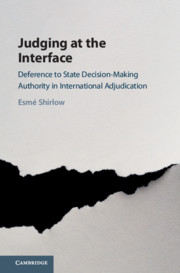Book contents
- Judging at the Interface
- Judging at the Interface
- Copyright page
- Dedication
- Contents
- Figures
- Tables
- Foreword by Judge James Crawford
- Acknowledgements
- Table of Cases
- Table of Treaties, Resolutions, and Declarations
- Abbreviations
- Introduction Deference and the International Adjudication of Private Property Disputes
- Part I Conceptual Framework and Methodological Approach
- Part II Deference in the International Adjudication of Private Property Disputes
- Part III The Systemic Role of Deference in International Law
- 8 Deference in Different Times and Contexts
- 9 The Systemic Implications of Deference in International Adjudication
- 10 Bringing Principles into Practice: Grappling with Deference in International Adjudication
- Conclusion Deference as a Story of International Law and Adjudication
- Appendix Data Tables
- References
- Index
Conclusion - Deference as a Story of International Law and Adjudication
from Part III - The Systemic Role of Deference in International Law
Published online by Cambridge University Press: 24 February 2021
- Judging at the Interface
- Judging at the Interface
- Copyright page
- Dedication
- Contents
- Figures
- Tables
- Foreword by Judge James Crawford
- Acknowledgements
- Table of Cases
- Table of Treaties, Resolutions, and Declarations
- Abbreviations
- Introduction Deference and the International Adjudication of Private Property Disputes
- Part I Conceptual Framework and Methodological Approach
- Part II Deference in the International Adjudication of Private Property Disputes
- Part III The Systemic Role of Deference in International Law
- 8 Deference in Different Times and Contexts
- 9 The Systemic Implications of Deference in International Adjudication
- 10 Bringing Principles into Practice: Grappling with Deference in International Adjudication
- Conclusion Deference as a Story of International Law and Adjudication
- Appendix Data Tables
- References
- Index
Summary
This Chapter concludes the book. It notes that the book has identified the structures of deference in international adjudication and the implications of deference for adjudication under public international law. It has developed a conceptual framework for understanding deference, to demonstrate that different modes of deference disclose differing approaches to dividing authority between domestic and international decision makers. The study has also linked deference to several fundamental debates about the relationship between public international law and domestic law, and between private property rights and State interests. Pursuing these lines of analysis, the book used deference to tell a story of international law, with international private property claims providing a useful setting for this story. By analysing approaches to deference in the private property cases of adjudicators in four such regimes, the study revealed the relationship between deference, State sovereignty, and power in international adjudication. It further identified how international adjudicators use deference to manage continuity and change, and to settle conflicting claims to authority.
Keywords
- Type
- Chapter
- Information
- Judging at the InterfaceDeference to State Decision-Making Authority in International Adjudication, pp. 268 - 275Publisher: Cambridge University PressPrint publication year: 2021

